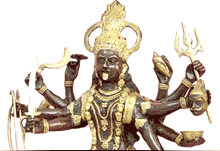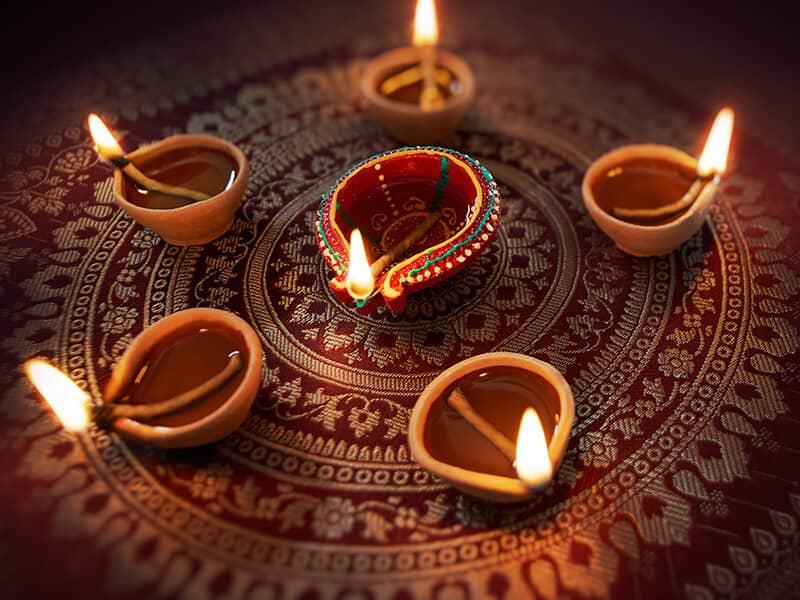What drew you to study Kali?
It began as a result of my upbringing. My father was an initiated disciple in the Ramakrishna mission in San Francisco in the late 1940s. He was white and had had an Episcopalian upbringing. He married an Anglican British woman. But he was so drawn to the Hindu tradition that he and she decided they would give my brother and me a dual religious upbringing. We want on one Sunday to the Episcopal church and the next Sunday to the local Ramakrishna swami, the Ramakrishna center. So I grew up with an interesting comparative religion upbringing. You could either say I was very enriched by this or very confused.

Because of this I was very interested in Bengal, the area where Ramakrishna lived. Kali was the deity he worshipped especially.
How do you understand Kali?
Kali is an extremely powerful goddess who encompasses all the opposites of life and of experience. I think some people have whitewashed her, but in the original conception of Kali, she was meant to symbolize the wholeness of life: life and death, beauty and ugliness, motherliness and destructiveness. I find that very refreshing. There's no fear of confronting the dark side of life. I think often in the west our conceptions of God are very one-sided or sweetened. We're afraid to attribute evil to God. I'm not trying to say that Kali is evil, but that there's more of an acceptance of her as representing the lights and darks. It has been helpful to me in my own Christian path to be enlivened by the conception of God that I find in Kali. She is a goddess of transformation; she can offer one spiritual realization and liberation. Just like any conception of a deity, when we try to limit that deity, it's unfortunate. Though I personally find the idea of her being a very sexualized feminist goddess slightly off-putting, I don't feel uncomfortable with it really, because it's just another way of Kali helping people to be transformed inside. So to you she's primarily a goddess of transformation?
I think so. To many people in Bengal, she does that by being the compassionate mother. To some tantrikas, who worship her as the sexual partner of Shiva, she does it through meditation experiences and a deeply sexualized realization of her. To some people here she may do that by giving them the courage to get out of an oppressive relationship. She helps people live. If you go into Kali temples, you see people offering something and taking a flower away that Kali has blessed. I've seen women-and men-holding on to something as close as they can get to the image-a bar, a stone. In real devotion, this is the mother to whom one can go for refuge. It's very heartwarming. Even the part of her worship that I find most personally alienating, which is goat sacrifice-even that people do with sincerity. They feel they're feeding the mother what she wants. And that, too, can be transforming. If you really feel you've done something the Lord-however you conceive of him or her--demands or wants, it gives meaning to your life. How is Kali viewed in India and in the West?
Kali is central in various parts of India, particularly in the East. In Bengal, Kali has been viewed increasingly through a very maternal, sweet lens. The people there say "she's our mother, she would never send us anything bad." You can see it in her images, which have become less and less frightening. She's become more mainstream; the rough edges are toned down. Westerners are not attracted to this sweetened Kali; they're attracted to the more death-defying Kali who presents a spectrum of opposites. Women's spirituality movements in particular tend to look on Kali as a feminist deity: a female figure who stands on the body of her husband and is wearing the decapitated remains of male demons. They view her as an image of power and rage. This is very dissimilar to what most average Bengalis would think. I've shared my research on the Western Kali in Calcutta, and find most people are shocked and indignant.
Exactly. Indians tend to downplay the darker side, and Westerners tend to downplay the sweeter side. It's even more poignant in my classes where I have South Asian students. Many are terribly offended; "how dare these white people appropriate our goddesses and make them into something they're not? It's colonization all over again." They feel the sexualization of the goddess doesn't show a true understanding of her spiritual nature. They feel that making Kali a symbol of white women's rage is a little inappropriate. I can understand that, and I always try, in teaching the course, to warn them that this is coming-but also try to challenge them that no one has a monopoly on the right way to interpret God. To the extent that Kali does represent rage, if it's not feminist rage, what is it?
Bengalis will say she's raging against injustice or demons, killing the demons of sin inside oneself. [With the goat sacrifice,] sometimes the goats are said to be one's own sins, the things that are obstacles to self-realization. As an example of how she's used in a political way, one of the essays in the book talks about how Kali is becoming a symbol of resistance for the Tamils in Sri Lanka-the demons she cuts down are the enemy. In the independence movement in India, the British were sometimes understood as the goats one should be offering to Kali. They were aligned with the evil she saves us from. You've written about recent manifestations of Kali in pop culture. What have you found? What has surprised you?
Ten years ago, I wrote an essay about Kali in the literature of western feminism and New Age spirituality. What I found was that Kali was being used as this symbol of feminist power and rage.
So recently I decided to update the research by looking on the Internet. I found two things: the first that the direction I'd seen ten years ago was still being followed, and perhaps even more outrageously. People saying that she's a sex goddess. So that which astounds and upsets my Indian students is even more in evidence today.
Sometimes they join our national conferences, like the American Academy of Religion, or set up their own websites to engage, attack, or politely disagree with the views of people who write books about certain things. They've lobbied universities to prevent the hiring of people they didn't like. I don't mean to imply that this is entirely pernicious. I'm sure 95% of such people are sincere and feel the sort of Hinduism being portrayed in the classroom is not real Hinduism. On the other hand, scholars feel the motives behind the anti-defamation movement are sometimes political-they support a nationalist Hindu political party-or derive from a regional perspective. For example, I had a student in one of my classes who would not believe there was animal sacrifice in Hinduism, because he'd grown up in a part of a country where it didn't happen, and his parents said it didn't happen. I had to show him pictures and slides. It sounds like you're calling for reconciliation between the two views of Kali-an integration.
We conceived of this book as a way of getting the two sides talking to each other. It's a way to get scholars to be aware of the two Kalis.
In the book, you'll see the many ways in which Kali is approached: the different places in India and the West where she is loved and resorted to. We've tried to make it a representative snapshot of her largess. Studying her, loving her, however you approach her is the task of a lifetime.

